January 24, 2022 feature
Twin-field quantum key distribution (QKD) across an 830-km fibre
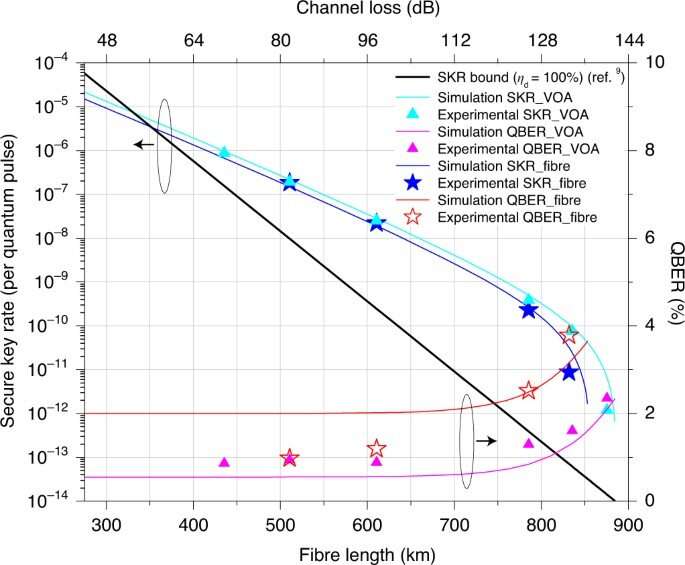
By using quantum key distribution (QKD), quantum cryptographers can share information via theoretic secure keys between remote peers through physics-based protocols. The laws of quantum physics dictate that photons carrying signals cannot be amplified or relayed through classical optical methods to maintain quantum security. The resulting transmission loss of the channel can limit its achievable distance to form a huge barrier to build large-scale quantum secure networks. In a new report now published in Nature Photonics, Shuang Wang and a research team in quantum information, cryptology and quantum physics in China developed an experimental QKD system to tolerate a channel loss beyond 140 dB across a secure distance of 833.8 km to set a new record for fiber-based quantum key distribution. Using the optimized four-phase twin-field protocol and high quality setup, they achieved secure key rates that were more than two orders of magnitude greater than previous records across similar distances. The results form a breakthrough to build reliable and terrestrial quantum networks across a scale of 1000 km.
Quantum cryptography and twin-field quantum key distribution (QKD)
Quantum key distribution is based on fundamental laws of physics to distribute secret bits for information-theoretic secure communication, regardless of the unlimited computational power of a potential eavesdropper. The process has attracted widespread attention in the past three decades relative to the development of a global quantum internet, and matured to real-world deployment through optical-fiber networks. Despite this, wider applications of QKD are limited due to channel loss, limiting increase in the key rate and range of QKD. For example, photons are carriers of quantum keys in a QKD setup, and they can be prepared at the single-photon level to be scattered and absorbed by the transmission channel. The photons, however, cannot be amplified, and therefore the receiver can only detect them with very low probability. When transmitted via a direct fiber-based link from the transmitter to the receiver, the key rate can therefore decrease with transmission distance. As a result, twin-field QKD can build a promising rate-distance relationship to overcome limits and achieve a secret key rate across long distances. Researchers have taken great efforts to develop its theory and experimentally demonstrate the unique advantages of the system. Wang et al. analyzed the cumulative results of recent long-distance fiber-based QKD experiments for fiber lengths beyond 450 km, revolving around twin-field quantum key distribution (TF-QKD) protocols to illustrate huge advantages of TF-QKD, while highlighting advances of the present study.
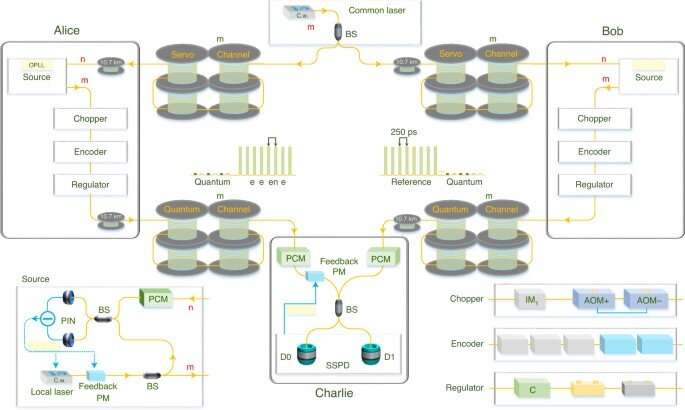
The four-phase twin field quantum key distribution protocol
The protocol contained five steps: At step one, Alice and Bob independently prepared a weak coherent state with randomly chosen intensity and probabilities. In step two, within the code mode, Alice (or Bob) can pick a 'key' bit and a 'basis' bit to randomly prepare a weak coherent state. During step three, Alice and Bob sent their weak coherent states to an untrusted middle station Charlie, who could make the incoming states interfere on a beamsplitter. The experimental setup contained two single-photon detectors located at two distinct outputs of the beam splitter labeled D0 and D1, respectively, where Charlie must publicly announce the clicks of D0 and D1. The team repeated the first three steps for a number of times (labeled Ntot). During step four, among the Ntot trials, only when just one of D0 and D1 clicks were they retained for further processing. Alice and Bob then broadcast the intensities for each retained trial to ultimately form the sifted key string. Finally, according to resulting lengths, Alice and Bob could share a secret key string with length G, from their sifted key string with a failure probability not larger than a value of ϵsec = 2-31 computed in the study.
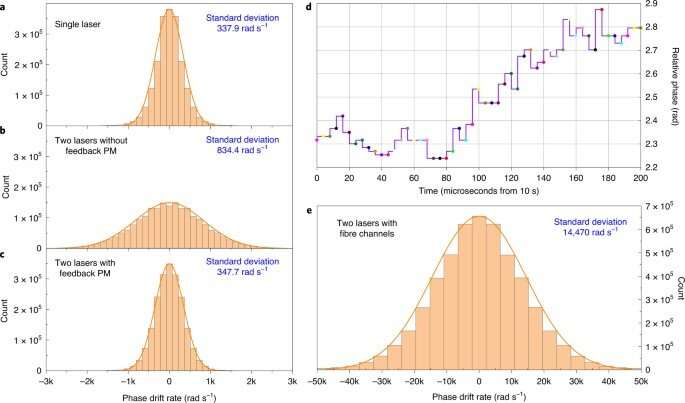
The twin-field quantum key distribution (TF-QKD) experimental system
The experimental setup required optical pulses from two remote users to stably interfere in the intermediate station (Charlie). The wavelength difference and phase difference between Alice and Bob's sources were designated to be relatively stable across time. Using a free running common laser, the team locked both Alice's and Bob's sources to reconcile their central wavelength values and employed a time division multiplexing method to compensate for fast phase drift introduced by the fiber channels. These fiber channels included the servo channel to transmit light from the common laser to Alice (or Bob), and the quantum channel adopted to transmit the time-multiplexed signal from Alice and Bob to Charlie. During the experiments, after passing through corresponding quantum channels and polarization compensation modules, Alice's and Bob's encoded twin fields interfered on Charlie's beam splitter for detection by two superconducting nanowire single-photon detectors. During experimental realization, the team formed a high-speed and low-noise TF-QKD system and optimized its performance by reducing the effect of noises originating from the source, channel and the detector. When compared to earlier experiments, a key advantage of the current experiment was its lack of requirements for optical amplifiers inserted to increase the power of classical signals, while reducing the complexity of the setup for scientists to generate remote, high-quality twin fields with reduced complexity and cost.
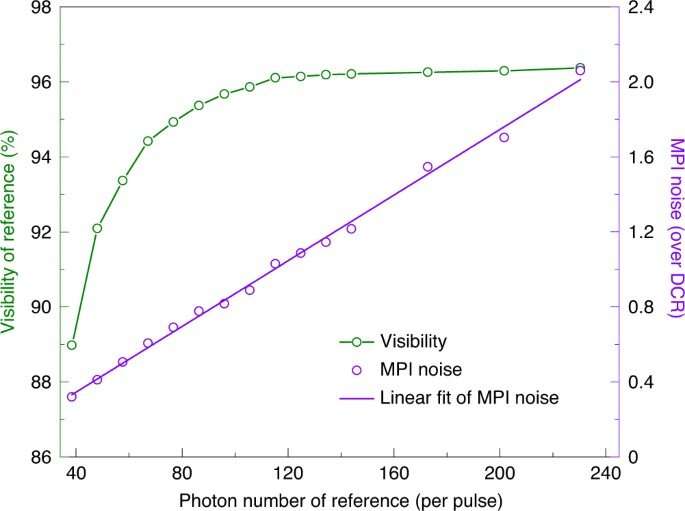
Generating twin fields—optimizing the setup
Wang et al. reduced the noise from the source and the servo channel to develop a highly sensitive and repeater-like laser source to ultimately generate twin-fields with 10-mw output power. They improved the sensitivity of the repeater-like laser source to work with very weak input power, even as low as 0.2 nW. The resulting twin-fields were generated with very high quality, which they optimized to achieve low multipath interference (MPI) noise, with high interference visibility in the quantum channels. The stability of the twin-field system played an important role to collect enough counts of quantum pulses, for the QKD system to function continuously for several weeks. The longest fiber-length across which Wang et al. could keep a relatively high interference visibility and achieve a positive key rate was 833.80 km, with a secure key rate of 0.014 bps after maximizing the outcome.
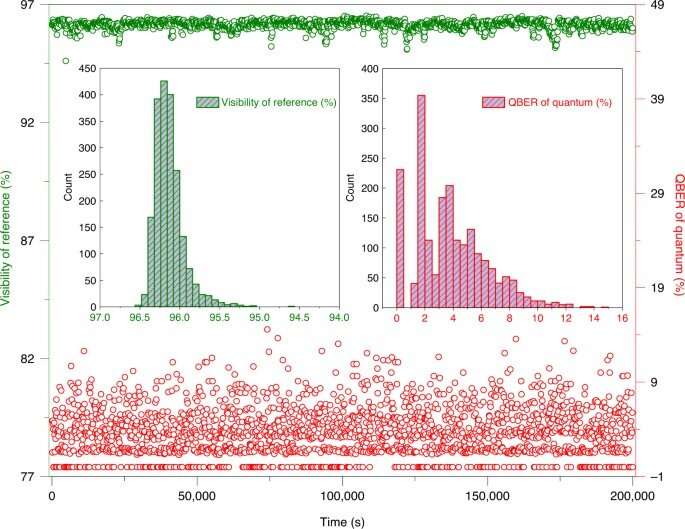
Outlook
In this way, Shuang Wang and colleagues showed how a fiber-based quantum key distribution (QKD) could be realized across a distance of 833.8 km with a channel loss of 140 dB. The new setup set records for tolerant channel loss and the long transmission distance of fiber-based QKD, while achieving secure key rates that outperformed previous twin-field quantum key distribution experiments at similar distances. The absence of optical amplifiers in the setup helped reduce the complexity and cost with great potential in field and network applications. The study provides a practical format to extend the transmission distance and pave the way towards a wider-range of QKD experiments.
More information: Shuang Wang et al, Twin-field quantum key distribution over 830-km fibre, Nature Photonics (2022). DOI: 10.1038/s41566-021-00928-2
Marcos Curty et al, Simple security proof of twin-field type quantum key distribution protocol, npj Quantum Information (2019). DOI: 10.1038/s41534-019-0175-6
Journal information: Nature Photonics
Provided by Science X Network
© 2022 Science X Network




















